
Nippon's Baguette formula
Shiao-Ping's excellent post on Mr. Nippon's Baguette formula and the images of her crumb and those in the book inspired me. From what I can tell, the 12 hour cool autolyse as a significant effect on the dough. The dough is sticky as Shiao-Ping cautioned and acted differently from any other 75% hydration dough I have worked with. It was trying to wind it's way up the shaft of the dough hook on my DLX mixer for one thing. It was window paining BEFORE kneading. After an initial mixing with the hook, I let it set for 15 minutes to allow the salt time to melt and the pinch of IDY time to incorporate before kneading for 1 minute on first speed and only 2 minutes on speed 2. The dough was smooth and silky from the first seconds of kneading. Quite beautiful really, if you know what I mean. I had pulled a small amount of dough after the initial 15 minute pause since it looked so smooth and was surprised to see how transparent the film was. After 2 minutes on speed level 2, I stopped and placed the dough in a lightly oiled plastic container and proceeded with the stretch and fold procedure that SP laid out. The total bulk ferment time was 3 hours with 5 S&F's.
One issue I had was that the 12 hour autolyse is supposed to be done at 60F. I looked around the kitchen for a drafty garage door that would serve as a place to maintain the cool temperature I had established with cool water. It worked out perfectly. The outside temp was a balmy 5F this morning and my bowl of autolyse flour and water measured at 61F. However, after adding the starter, salt and IDY together the DDT is 22C or about 72F. The friction factor isn't any where near that spread so I floated the dough bowl in warm water during the first 20 minutes in preparation for the first S& F. It worked out fine but it's a little clumsy having to make that adjustment. I wanted to follow the protocol as closely as I could and being wildly off the DDT would be a big error.
Shaping and proofing was as normal. I wanted to try the scoring pattern of SP's second set of images where the chef is trying to suggest wind in his slashing pattern. To me it looks like a series of slashes that wrap the long loaf with one following the last and the gaps bridged by another set of cuts. I won't pretend to suggest that it turned out anywhere near the chefs pattern. It took me a few years to be just moderately proficient at the traditional pattern. This is way harder but I will continue to practice. I think the effect of so many cuts will be to allow the crumb to expand more giving room for that airy open crumb structure. We will see. As I write this, I have just removed the three baguettes from the oven. I spritzed 2 of the loaves and left one with the surface flour on it. I can see I should of cut deeper already.
I will cut one open and we shall see if we are going out for dinner or not.
Eric
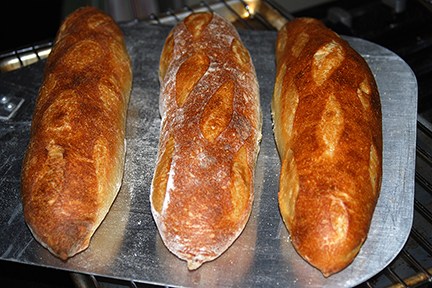
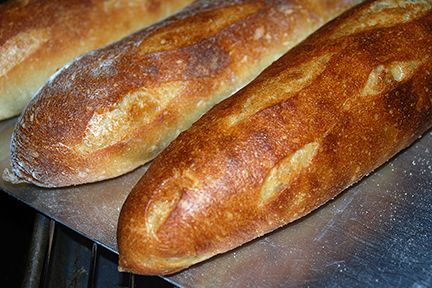
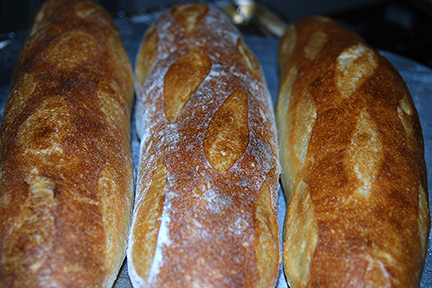
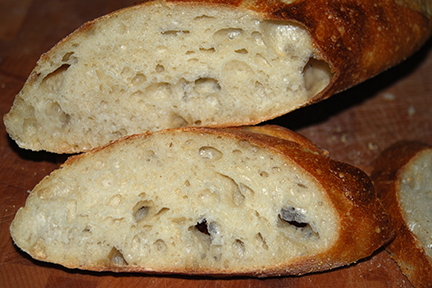
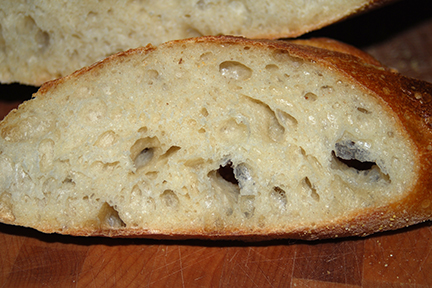


Comments
Eric, when I look at your baguettes, I think of good food.
When I look at Mr. Nippon's baguettes, I think of good art.
How did they taste?
Yea, I'm a technician and not an artist. It was however my first stab at this method (pun intended).
They were/are pretty good for all white flour. I usually add a touch of rye to improve the flavor and after taste.
Eric
My post was meant to be a compliment, Eric.
I could happily dive into your baguettes because they look well made and "earthy" (if you get what I mean), but I wonder about the taste of the Nippons. They are very beautiful artistically, but are we eating crumb or crust? Did Mr. Calvel bake such baguettes? I don't know. Could that webbed, intricate crumb be replicated consistently, day after day? Again, I don't know. Do they even taste good? No idea.
I do know I admire your explorative nature and taking on that bake. And yes, gotta have some rye!
I like the sound of that...The crumb look amazing...Great write up...It is interesting that the autolyse is supposed to be done at 60F. Do you think you could do it without a mixer? I am not going to have one for a while!
Judd
I know it was Lindy. Thank you for your thoughtful words.
Your questions are all valid and I am only now learning about this method. We do eat both the crust and crumb and for the first time I am thinking that the crust may seriously influence the crumb. Prof. Calvel stressed careful handling of the dough and strict temperature control. He also taught the benefits of autolyse and extended fermenting. This combination of procedures delivers pretty good bread. To be fair it's my first attempt so I can't say for sure if I like it. It would be hard for me to replicate the 60F 12 hour time period in the summer and I can't believe that a commercial operation would bother with 5 stretch and folds through the day. That's the trouble with MacGuire, and Lepards minimal handling process also. Having to be around the kitchen during the entire bulk ferment folding every 20 minutes is to much attention for me.
Right now I'm thinking the flavor would be better if the bulk ferment time were longer. Either a smaller percent of starter and or fermenting a larger portion of the total flour by moving some of the flour in the autolyse into the starter.
Judd: I don't see any reason this couldn't be done by hand. It is sticky due to the long autolyse. The flour gets fully hydrated and I think the enzymes get activated. I'll try it by hand next time. I suspect a good session of slap and flip ala Bertinet method would work to get the salt and levain fully incorporated.
Eric
Eric, Nice baguettes, i have yet to make decent baguettes myself. Iam waiting for my new refregirator. My current refr. is too small to house a retarded baguette.
BTW, do you prefer sour taste in your bread, or you like it moderatly sour?
Mebake
Mebake, I don't care for a sour Baguette and this wasn't. Actually the Boabsa Baguettes are not sour either.
I think this formula would benefit from a retardation period for better flavor.
Eric
I read Mr. Nippon's baguette formula. Is the liquid starter in the recipe a 100% hydration sourdough starter? Would like to try this one.
Thanks, Erlinda
I think so.
Eric